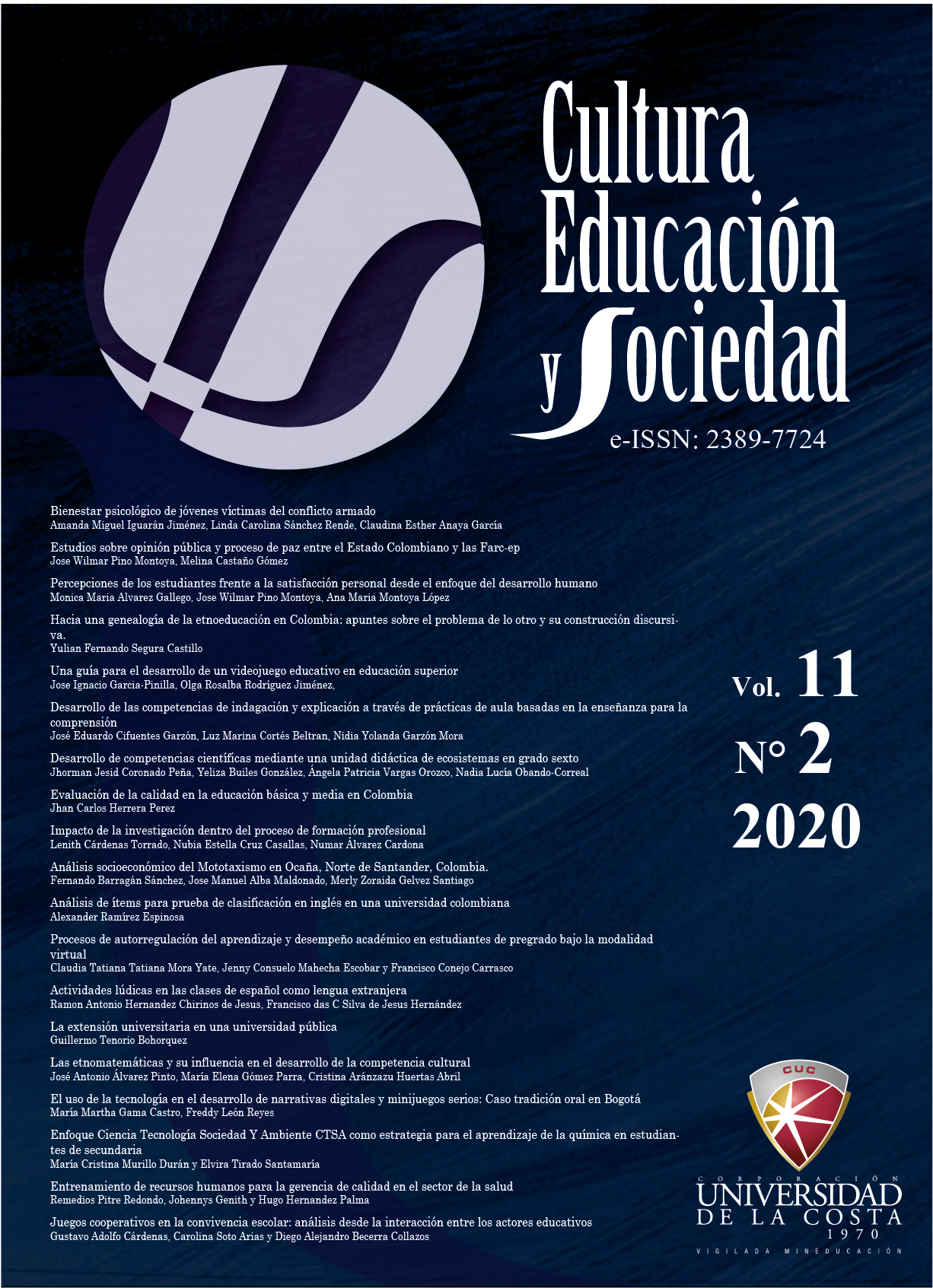Item Analysis on an English Placement Test at a Colombian university
DOI:
https://doi.org/10.17981/cultedusoc.11.2.2020.11Keywords:
Foreign languages evaluation, Testing, Placement test, Item analysis, Language testing literacyAbstract
This article reports the results of a research project in which the difficulty index (IF) and discrimination index (ID) were measured in an English placement test designed by and for a Colombian public university. The test was made up of a grammar and vocabulary section, an oral comprehension section and a written comprehension section. The measurement of the indexes allowed categorizing excellent, acceptable and defective items for their subsequent correction or discard. The results of the study suggest that the items found to be defective correspond to question with poor distractors and with problems of ambiguity in the instruction; likewise, the study confirms the lack of language assessment literacy (LAL) among foreign language teachers and suggests the need for explicit training in item design.
Downloads
References
Bachman, L. F. (2004). Statistical Analyses for language Assessment. Cambridge: Cambridge University Press.
Brown, J. D. (2011). Testing in Language Programs: A Comprehensive Guide to English Language Assessment New Edition. New York: McGraw-Hill.
Brown, D. (2004). Language Assessment - Principles and Classroom Practice. White Plains: Pearson education.
Carr, N. (2011). Designing and Analyzing Tests. Oxford: Oxford University Press.
Ebel, R. L. y Frisbie, D. A. (1986). Essentials of Education Measurement. Englewood Cliffs: Prentice Hall.
Fernández, M. (2007). Propuesta Metodológica para la Creación de un Nuevo Examen de inglés en las Pruebas de Acceso a la Universidad. [Tesis Doctoral]. Granada: Editorial de la Universidad de Granada.
Giraldo, F. (2018a). Language assessment literacy: Implications for language teachers. Profile: Issues in Teachers’ Professional Development, 20(1), 179–195. http://doi.org/10.15446/profile.v20n1.62089
Giraldo, F. (2018b). A Diagnostic Study on Teachers’ Beliefs and Practices in Foreign- Language Assessment. Íkala, Revista de Lenguaje y Cultura, 23(1), 25–44. http://doi.org/10.17533/udea.ikala.v23n01a04
Giraldo, F. (2019). Designing Language Assessments in Context: Theoretical, Technical, and Institutional Considerations. HOW Journal, 26(2), 123–143. https://doi.org/10.19183/how.26.2.512
ILTA. (2001). Código Ético. [Online]. Disponible en https://www.isa-sociology.org/es/sobreisa/codigo-etico-440
Inbar-Lourie, O. (2013). Guest Editorial to the special issue on language assessment literacy. Language Testing, 30(3), 301–307. https://doi.org/10.1177/0265532213480126
Janssen, G. & Meier, V. (2013). Establishing placement test fit and performance: Serving local needs. Colombian Applied Linguistics Journal, 15(1), 100–113. https://doi.org/10.14483/udistrital.jour.calj.2013.1.a07
López, A. & Bernal, R. (2009). Language testing in Colombia: A call for more teachereducation and teacher training in language assessment. Profile: Issues in Teachers’ Professional Development, 11(2), 55–70. Available from http://www.bdigital.unal.edu.co/16543/1/11442-28040-1-PB.pdf
Malau-Aduli, B. S. & Zimitat, C. (2012). The Analysis of Multiple-Choice Items of the Test of an Introductory Course in Chemistry in a Nigerian University. International Journal of Learning, 18(4), 237–246. https://doi.org/10.18848/1447-9494/CGP/v18i04/47579
Núñez, A. & Téllez, M.F. (2009). ELT Materials: The Key to Fostering Effective Teaching and Learning Settings. Profile: Issues in Teachers’ Professional Development, 11(2), 171–186. Available from https://revistas.unal.edu.co/index.php/profile/article/view/11449
Palés-Argullós, J. (2010). ¿Cómo elaborar correctamente preguntas de elección múltiple? Educación Médica, 13, 149–155. https://doi.org/10.4321/S1575-18132010000300005
Paltridge, B. (1992). EAP placement testing: an integrated approach. English for Specific Purposes, 11, 243–268. https://doi.org/10.1016/S0889-4906(05)80012-2
Sugianto, A. (2020). Item Analysis of English Summative Test: EFL Teacher-Made Test. Indonesian EFL Research & Practice, 1(1), 35–54. Disponible en http://journal.ahsanta.ac.id/index.php/EFL/article/view/13
Taylor, L. & Geranpayeh, A. (2011). Assessing listening for academic purposes: Defining and operationalising the test construct. Journal of English for Academic Purposes, 10, 89–101. https://doi.org/10.1016/j.jeap.2011.03.002
Toksöz, S. & Ertunç, A. (2017). Item Analysis of a Multiple-Choice Exam. Advances in Language and Literacy Studies, 8(6), 141–146. http://dx.doi.org/10.7575/aiac.alls.v.8n.6p.141
Tomlinson, B. (2005). Testing to learn: a personal view of language testing. ELT Journal, 59(1), 39–46. https://doi.org/10.1093/elt/cci005
Wall, D., Claphman, C. & Alderson, C. (1994). Evaluating a placement test. Language Testing, 11, 321–344. https://doi.org/10.1177/026553229401100305
Published
How to Cite
Issue
Section
License
Copyright (c) 2022 CULTURA EDUCACIÓN Y SOCIEDAD

This work is licensed under a Creative Commons Attribution-NonCommercial-NoDerivatives 4.0 International License.
![]()
Creative Commons 2020 CULTURA EDUCACIÓN Y SOCIEDAD
This article is under international license Creative Commons Reconocimiento-NoComercial-SinObrasDerivadas 4.0.
The published articles are the sole responsibility of their authors and do not necessarily reflect the opinions of the editorial committee.
CULTURA EDUCACIÓN Y SOCIEDAD respects the moral rights of its authors, who assign to the editorial committee the patrimonial rights of the published material. In turn, the authors inform that this work is unpublished and has not been previously published.
All articles are under a:
Licencia Creative Commons Atribución-NoComercial-SinDerivadas 4.0 Internacional.
![]()


 English
English
 Español (España)
Español (España)




_12.53_.27_p_. m_._3.png)





_12.57_.35_p_. m_._3.png)
_12.50_.37_p_. m_._3.png)



